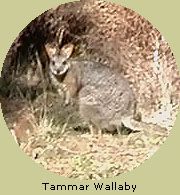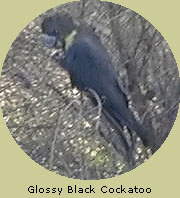|
Introduction
The wonderful unique and abundant animals of Kangaroo Island are
both introduced to the Island since settlement or are native to
the Island as sub species of those found on mainland Australia.
The isolation of the Island thousands of years ago has produced
a predator free environment. Dingos, Rabbits and Foxes were introduced
to Australia after Kangaroo Island was isolated from the mainland.
Foxes and Rabbits were introduced to Kangaroo Island unsuccessfully
in the 1800's.
All records of aboriginal people here end around the same time
as the island was cut off from mainland Australia by rising sea
levels. Respecting the land these people did not kill off
the animals and it is not known why they left here. Artefacts and tools have been located at various sites indicating
that there have been aboriginal people living here as these items
seem to be dated about c. -10,000 years. Although some of these
tools could have been made or brought here by the Aboriginal women
that were brought here by the sailors in the early years before
settlement. It is known that each camp had 3-4 women working at
collecting food and hunting.
Artefacts and tools have been located at various sites indicating
that there have been aboriginal people living here as these items
seem to be dated about c. -10,000 years. Although some of these
tools could have been made or brought here by the Aboriginal women
that were brought here by the sailors in the early years before
settlement. It is known that each camp had 3-4 women working at
collecting food and hunting.
Overview
There are 18 native Mammals on Kangaroo Island. Eight are marsupial
(with pouches), 2 are monotremes (egg laying ) and 8 are placental
(mice and bats). There are 6 well known marine mammals living
close to the shores of this sanctuary Island.
Marsupials
The sub-species of the Western Grey Kangaroo which gives the island
its name, are physically a very appealing Kangaroo. It has a thicker
coat, darker markings around the eyes and a light patch on its
breast, unlike its mainland cousin. It is also shorter than the
Kangaroos on the mainland. The Kangaroo has a gentle nature to
match its looks and is shy of people, except at Flinders Chase
National Park, where some kangaroos have been 'tamed' through
human contact and will happily approach cars and people.
It is prohibited to feed the Kangaroos
and other Wildlife on Kangaroo Island

The Tammar Wallaby was abundant on the mainland prior to the introduction
of competing animals and predators. It exists now only on islands
off the coast of South and Western Australia and Kangaroo Island
is one of those places. Here the Tammar Wallaby has thrived in
the absence of predators and can be seen as it moves around at
night and is prolific in the township of American River where
in summer it comes into the town looking for food in the gardens
of our homes.
The Common Brushtail Possum is also abundant, and a nuisance to
farmers and fruit growers as it has adapted too well to cleared
forest land. Although they are ground feeders generally, they
have a love of domestic fruits.
It spends the day sleeping in tree hollows and the young are carried
at first in a pouch and then on the mothers back. The Brushtail
is also the major predator of the Glossy Black Cockatoo's chicks
and eggs. This animal has a waddling gait if seen walking on the
ground but if it goes into a tree or onto a power cable it becomes
a skilled aerialist.
Koalas were introduced here in the 1930's to build a colony in
the event of the extinction of the mainland Koala population.
The Koala is an icon of Australia and thrived on the island with
a lack of predators and an abundance of Koala preferred gum leaves,
these being from the Manna, Swamp and Blue Gum. The Koala eats
about 0.5 kg (1 lb.) of leaves each day.
Their numbers increased so well that the Koala was eating its
way to starvation with the population of Koalas here reaching
over 5000. A programme was undertaken to reduce the numbers to
a sustainable population. 2500 were sterilised and 850 were relocated
to mainland sites. The birth rate has slowed and the Koala is
now at comfortable numbers on Kangaroo Island although monitoring
of numbers will continue. They can be viewed at Hanson Bay, Cygnet
River and Flinders Chase National Park.
The only endemic species to Kangaroo Island is represented by
the Sooty Dunnart. A shy and small marsupial, it was found
in 1969 in a mallee scrub area. Not many have been found but it
has been identified as a new species and as the only endemic species
to Kangaroo Island it is worthy of mention.
Monotremes
Short-nosed Echidnas are a blonder sub-species of a mainland monotreme.
These animals lay eggs and are covered in sharp spines like a
porcupine. They burrow into ant and termite mounds for food and
there young are hatched after incubation in a termite mound.
The young are called 'puggles' and are carried by the mother in
a pouch for about 50 days where they suckle from milk patches.
They are then placed in a nursery burrow and the mother returns
about every 6 days to suckle them for the next 6 months.
They are then left to fend for themselves, as there is
no interaction between adults and young after this. Echidnas are
often seen walking beside roads and as they are nocturnal feeders
are seen best in the early evenings but can be seen at any time
of day, especially towards the western end of the Island.
15 Platypus were introduced successfully between 1928 and 1948.
They remain on Kangaroo Island in the Flinders Chase Conservation
Park. Safe from predators their exact numbers now are unknown.
An interesting mammal that lays eggs in burrows on the sides of
ponds and slow moving rivers. They eat worms and small crustaceans
that live in the mud. They are expert swimmers and their movement
is much like that of an otter. An unusual and secretive animal
it is often referred to as the 'Duck Billed Platypus" because
of its leathery bill shaped much like a ducks through which it
senses the movements of worms and yabbies (shrimp-like crustaceans).
It has webbed feet and a flat tail that resembles a beaver. Sitting
quietly by a pond (billabong) in the Flinders Chase National Park
often results in a view of these fascinating animals.
Marine Mammals
There are 6 kinds of marine mammals associated with Kangaroo Island.
The Australian Sealions are found on the South coast. Guided tours
take people into the heart of the colony of about 600 seals at
Seal Bay National Park. The Australian and New Zealand Fur Seals
can be seen at Admirals Arch near Cape du Couedic. Commonly these
animals can be seen at other coastal locations along the South
Coast. The seals were nearly hunted to extinction, are now protected
and increasing in numbers.
In 1803 Captain Pendleton of the American Brig the 'Union' was
directed to the island by Captain Nicolas Baudin. Here he
found seals in abundance at the place now called American River.
The crew of the 'Union' reportedly killed over 60,000 taking
the fur skins and the oil, which was shipped to Sydney and China.
There are no longer seals at the eastern end of the Island.
The Southern Right Whale swims off the coast of the Island when
the female comes closer to shore to 'calf' in the warmer waters.
These enormous animals can be seen swimming in Nepean Bay at certain
times of the year as well as along Back Stairs Passage on clear
days. The whales can also be spotted off the South Coast near
Vivonne Bay.
Bottle Nosed and Common Dolphins also abound in the waters around
Kangaroo Island. they can be seen swimming at the bows of boats
as they 'race' them to fishing grounds. These playful animals
are a delight to watch as they swim with ease and play without
regard for being watched.
Footnote
There are many more animals on Kangaroo Island and the above is
commonly what visitors to the island look for and see. The rich
fauna of both native and introduced species makes this Island
a sanctuary for Australia's threatened and sadly disappearing
animals. It is recommended to take a tour with a guide to see
the animals in their natural habitat.
|